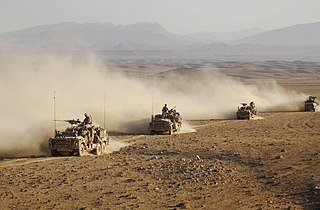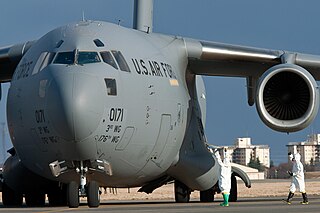
The Special Air Service Regiment, officially abbreviated SASR though commonly known as the SAS, is a special forces unit of the Australian Army. Formed in 1957 as a company, it was modelled on the British SAS with which it shares the motto, "Who Dares Wins". Expanded to a regiment in August 1964, it is based at Campbell Barracks, in Swanbourne, a suburb of Perth, Western Australia, and is a direct command unit of the Special Operations Command.

Chemical, biological, radiological and nuclear defense or NBC protection is protective measures taken in situations in which chemical, biological, radiological or nuclear hazards may be present. CBRN defense consists of CBRN passive protection, contamination avoidance, and weapons of mass destruction mitigation.

The South African Army Engineer Formation is the controlling entity of all South African Army military engineering units. The Formation is currently commanded by the General Officer Commanding (GOC); Brigadier General C. Buyse

Canadian Special Operations Forces Command is a command of the Canadian Armed Forces. It is responsible for all special forces operations that respond to terrorism and threats to Canadians and Canadian interests around the world.

The special forces of the Australian Defence Force are units of Special Operations Command and associated units of the Royal Australian Navy and the Royal Australian Air Force that conduct and or support special operations to advance and protect the national security of the Commonwealth of Australia. The special forces of Australia have a lineage to a variety of units raised in the Second World War such as the Independent and Commando Companies, Z Special Unit, Navy Beach Commandos, and the Coastwatchers. Australian special forces have most recently been deployed to Iraq in Operation Okra as the Special Operations Task Group, as the Special Operations Task Group in Afghanistan, in Afghanistan in support of the Australian Secret Intelligence Service and regularly for counter-terrorism pre-deploy to locations of major domestic events throughout Australia in readiness to support law enforcement such as the 2014 G20 Brisbane summit.

The Canadian Joint Incident Response Unit (CJIRU) of the Canadian Armed Forces was created "to provide timely and agile broad-based CBRN support to the Government of Canada in order to prevent, control and mitigate CBRN threats to Canada, Canadians, and Canadian interests". It is a sub-unit of the Canadian Special Operations Forces Command (CANSOFCOM).

The Royal Australian Engineers (RAE) is the military engineering corps of the Australian Army. The RAE is ranked fourth in seniority of the corps of the Australian Army, behind the Staff Cadets, Armoured and Artillery Corps. The corps was formed by the amalgamation of the various colonial engineer corps of the states and territories of Australia in 1902 and since then has served in various conflicts including World War I, World War II and the Vietnam War. The corps has also served on numerous peacekeeping operations and was heavily involved in the Australian contribution to the war in Afghanistan.

The 20th CBRNE Command is the United States Army headquarters for defense against Chemical, Biological, Radiological, Nuclear, and high-yield Explosives (CBRNE), headquartered on the site of the defunct Edgewood Arsenal chemical weapons production facility at Aberdeen Proving Ground in northern Maryland.

No. 26 Squadron RAF Regiment was an RAF Regiment Field Squadron between 1951 and 2008. It was reformed in 2010 as a specialist Chemical, Biological, Radiological and Nuclear (CBRN) Squadron initially based at RAF Honington in Suffolk. When it was a Field Squadron, it served at locations such as RAF Abu Sueir, RAF Habbaniya, RAF Amman, RAF Tymbou, RAF Nicosia, RAF Changi, RAF Bicester, RAF Gutersloh and RAF Laarbruch. It took part in Operation's Granby and Desert Storm in 1990-91 and latterly it was based at RAF Waddington as a Rapier Squadron.

The Chemical Biological Incident Response Force (CBIRF) is a Marine Corps unit responsible for countering the effects of a chemical, biological, radiological, nuclear, or high-yield explosive (CBRNE) incident, support counter CBRN terrorism, and urban search and rescue when CBRN incident. They were activated in April 1996 by General Charles C. Krulak, then Commandant of the Marine Corps. The unit is based at Naval Support Facility Indian Head in Indian Head, Maryland and falls under the command of the United States Marine Corps Forces Command.

8th Brigade is an Australian Army Reserve training formation. It is headquartered in Sydney, and has subordinate units in various locations around New South Wales and the rest of Australia. These units are tasked with delivering basic and initial employment training to Reserve soldiers.
The United States Marine Corps is tasked by Department of Defense directive to "conduct complex expeditionary operations in the urban littorals and other challenging environments" and "conduct amphibious operations, including engagement, crisis response, and power projection operations to assure access." Before 2006, the Marine Corps was the only branch of the Armed Forces that did not have any of its special warfare elements participating in the United States Special Operations Command (USSOCOM), due to confining its special operations capabilities only for the purpose to the Fleet Marine Force.
The 2nd Combat Engineer Regiment (2 CER) is an Australian Army combat engineer regiment located at Gallipoli Barracks in Brisbane, Queensland. It is part of the Australian 7th Brigade, attached to Forces Command (Australia).
5th Engineer Regiment is a Reserve unit of the Royal Australian Engineers. Originally raised as the "5th Combat Engineer Regiment" in 1995 from the 4th Field Engineer Regiment, it is based in Holsworthy, Sydney, with one of its sub-units based at the multi-user depot HMAS Harman, in Canberra and another at Orchard Hills and Dundas. Some of the unit's subunits draw lineage from the 4th and 5th Field Companies, which were raised for service during World War I.
The 1st Combat Engineer Regiment is a combat engineer regiment of the Australian Army. Based in the Northern Territory and attached to 1st Brigade, it is a Regular Army unit of the Royal Australian Engineers and is tasked with providing mobility and counter mobility support.
The 8th Engineer Regiment was a reserve engineer regiment of the Australian Army. Originally raised as the "8th Combat Engineer Regiment" in 1995, the unit provided support during the 2000 Sydney Olympics and the APEC Australia 2007, and was headquartered at Bullecourt Barracks, Adamstown, New South Wales, where it formed part of the 8th Brigade.
The 11th Engineer Regiment(11ER) is an Australian Army Reserve engineer regiment trained for sapper/combat engineer and construction engineer operations. While 11 ER was formed on 1 January 2014 as a result of recent Australian Army modernisation efforts, 11 ER's lineage is traced back to early Queensland volunteer engineer units as early as 1879. In 1916, 11th Field Company was formed and during World War I, this unit was renowned for action during the Battle of the Somme and the Hindenburg Line. During World War II, it fought the Japanese during the Kokoda Track campaign and on Bougainville Island. The Regiment's Headquarters is located at Gallipoli Barracks in Brisbane, Queensland with subunits located across Queensland. 11ER is part of 11th Brigade, attached to Forces Command.

The Emergency Management (EM) career field is the United States Air Force's (USAF) primary organization responsible for implementing an installation-level EM program. Emergency Managers, also known by the Air Force Specialty Code (AFSC) 3E9X1, are the Air Force's subject matter experts for all non-medical Chemical, Biological, Radiological and Nuclear (CBRN) passive defense and consequence management matters.
During wartime operations, 3E9X1s are assigned to CBRN reconnaissance teams responsible for detecting, identifying, quantifying, and collecting CBRN material ensuring mission continuation and force survivability.
28 Engineer Regiment (C-CBRN), Royal Engineers is a regiment of the British Army that focuses on countering chemical, biological, radiological and nuclear (C-CBRN) hazards in the environment. Its operational chain of command is 29 Group, under 8th Engineer Brigade as part of 1st (UK) Division.
14 CBRN Regiment, Sri Lanka Engineers is a regiment of the Sri Lanka Army that focuses on countering chemical, biological, radiological and nuclear (CBRN) hazards in the country. The Sri Lanka Navy and Sri Lanka Air Force also maintain CBRN units in addition to the Army's CBRN regiment. The regiment evolved from the first CBRN squadron that Major General Jagath Gunawardena, the current colonel-commandant of Sri Lanka Engineers, established.













